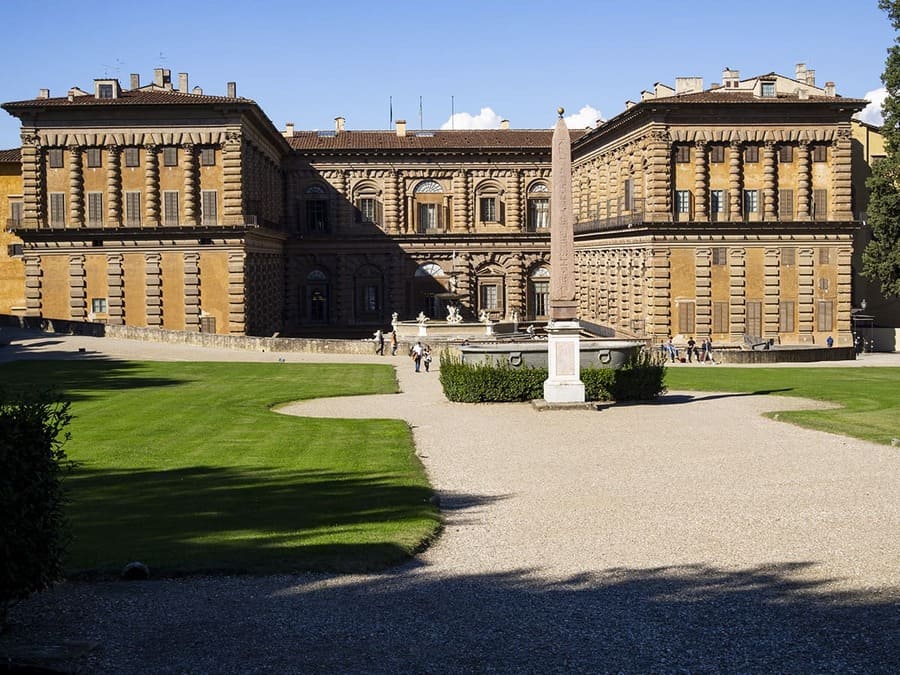Are you planning four days in Florence and looking for must-see attractions?
Among the city’s many wonders, Palazzo Pitti is undoubtedly one of the top answers to the question “what to see in Florence?”: once a powerful symbol of ducal authority, this immense private residence served for centuries as the palace of the Grand Dukes of Tuscany – from the Medici to the Habsburg dynasties.
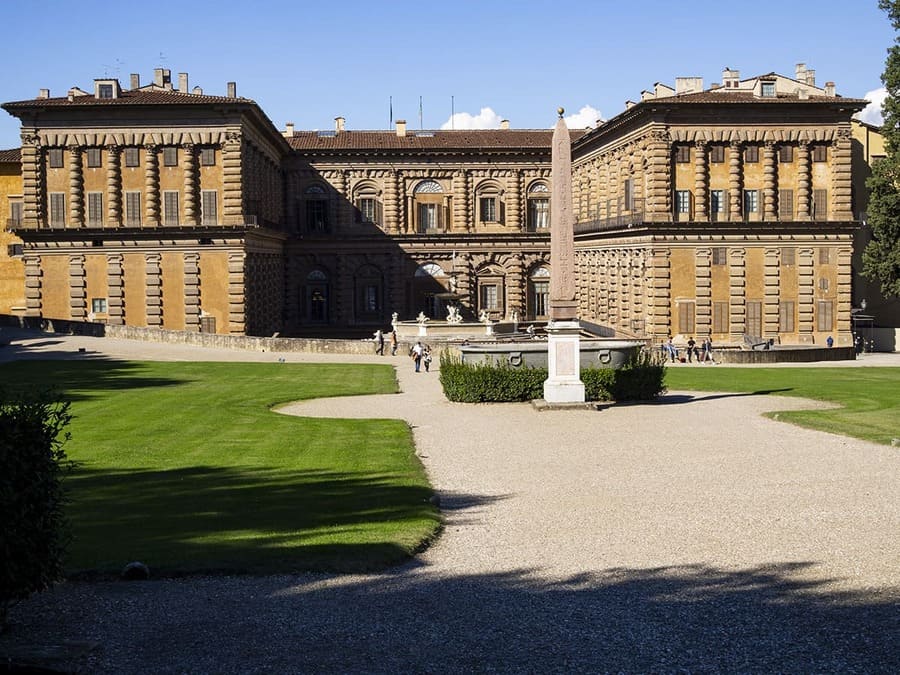
Today, it’s much more than just a museum – it’s a museum hub, home to seven different museums and to the iconic Boboli Gardens.
Visiting the entire complex requires a full day, but with a bit of planning, you can make your experience manageable and memorable.
Here’s a complete guide to help you make the most of your visit to the Pitti Palace.
Pitti Palace Florence: then and now
The Pitti Palace was originally designed in the 15th century for the Pitti family.
The Pitti family built the first, central part of the palace, which was, however, much smaller than the grand structure we see today. Until the 1550s, only this central section of the building existed.
The structure we see today began to take shape after it was acquired by Eleonora of Toledo and her husband Cosimo I de’ Medici in 1549. They expanded the residence and transformed the grounds behind it into what became the stunning Boboli Gardens.
Notable architects such as Bartolomeo Ammannati, Giulio and Alfonso Parigi contributed to the palace’s evolving design over the centuries. By the 19th century, the palace took on its final form, including the two side wings that now frame the main square.
After the Medici line died out, the Habsburg-Lorraine dynasty took residence at the Pitti. They added a smaller wing to the main residence, building the so-called “Palazzo della Meridiana”, which became their actual apartment.
Later, during the Napoleonic era, the palace was restored for Elisa Baciocchi, Napoleon’s sister, who ruled in Tuscany with the title of the Grand Duchess.
When Florence became the capital of unified Italy, the palace briefly served as the royal residence of King Victor Emmanuel II.
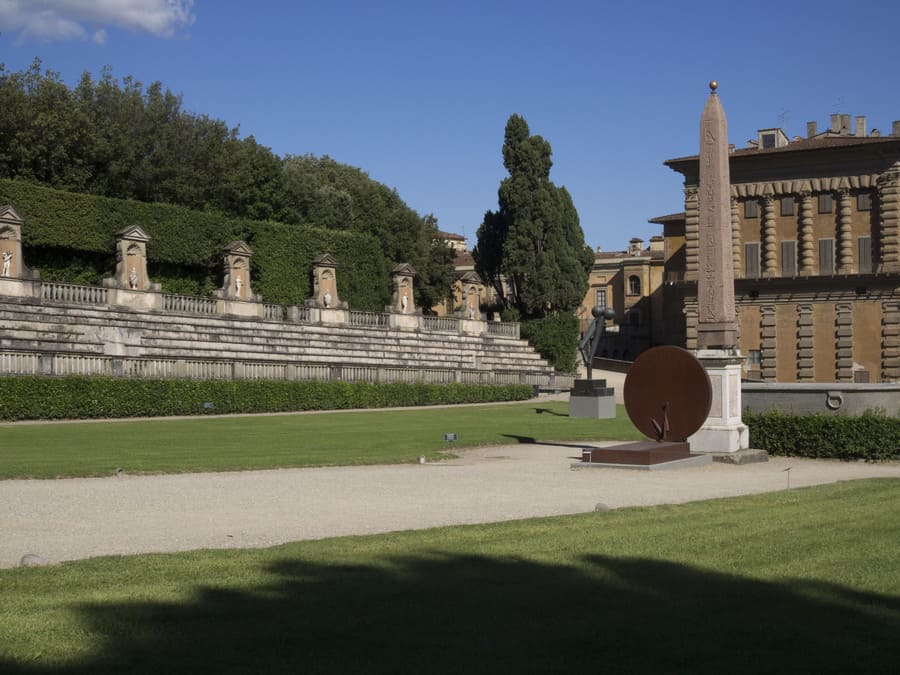
What is inside the Pitti Palace?
Today, the Pitti Palace is a big museum complex. During your visit, you’ll have the opportunity to explore:
- The Palatine Gallery
- The Gallery of Modern Art
- The Treasury of the Grand Dukes
- The Royal Apartments
- The Museum of Russian Icons
- The Porcelain Museum (temporary closed)
- The Museum of Costume and Fashion
- The Boboli Gardens
Palatine Gallery
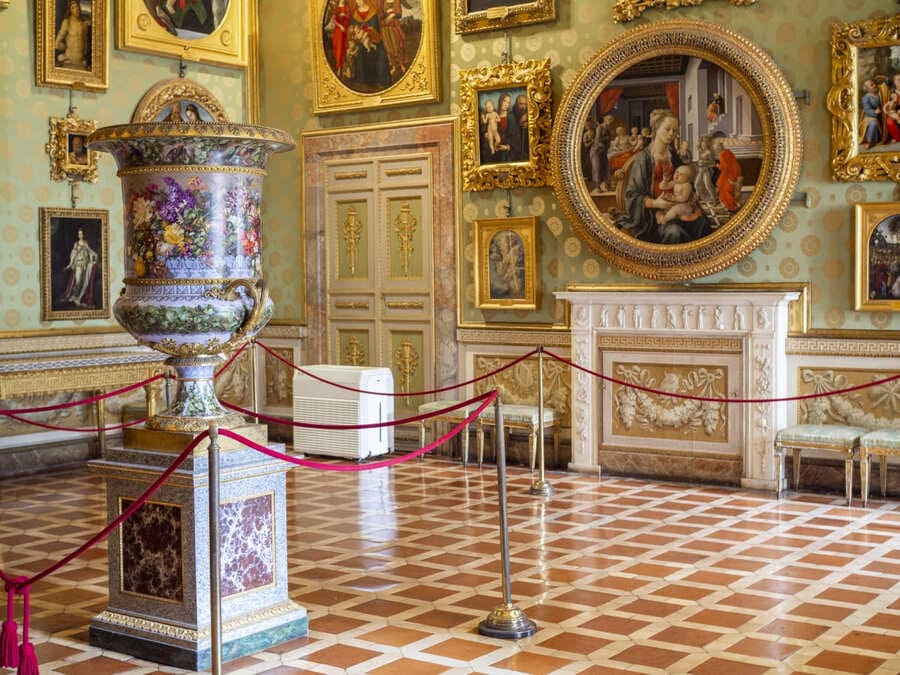
The Palatine Gallery is one of my absolute favorite museums in Florence, and it’s actually the most important art collection housed within the Pitti Palace.
What makes it truly special is the historical display of art inside the gallery rooms – the paintings are arranged in the traditional manner, covering almost every inch of the walls, creating a rich, immersive atmosphere.
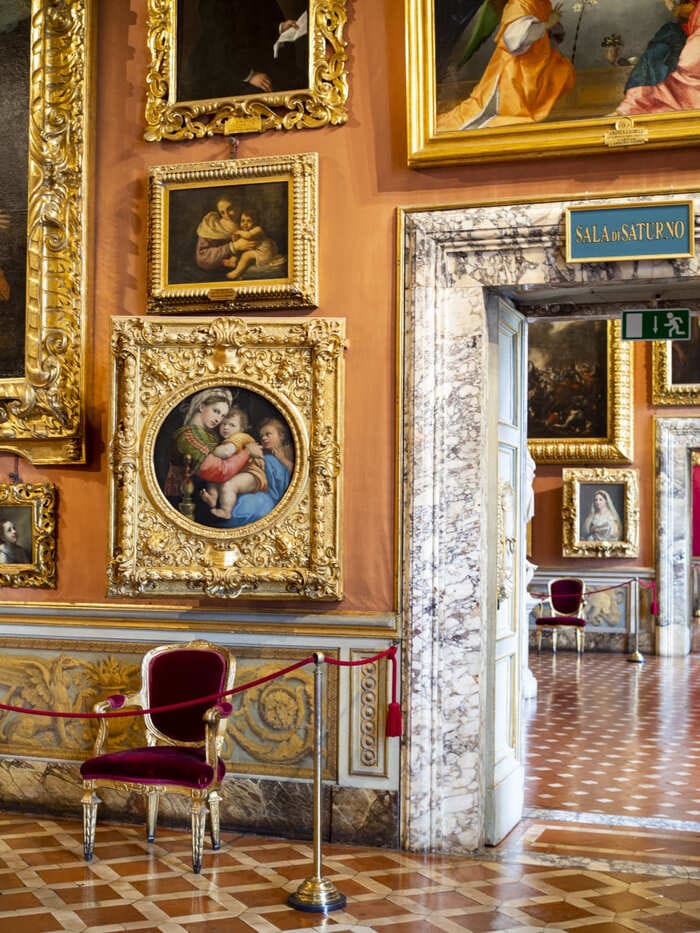
The gallery was established by the Habsburg-Lorraine dynasty, who inherited the Grand Duchy of Tuscany from the Medici family. They chose to showcase the Medici’s vast art collection on the first floor of the palace.
The Palatine Gallery is a must-see for lovers of Raphael, as it holds the largest collection of Raphael’s works in the world. You won’t find this many Raphaels in any other museum.
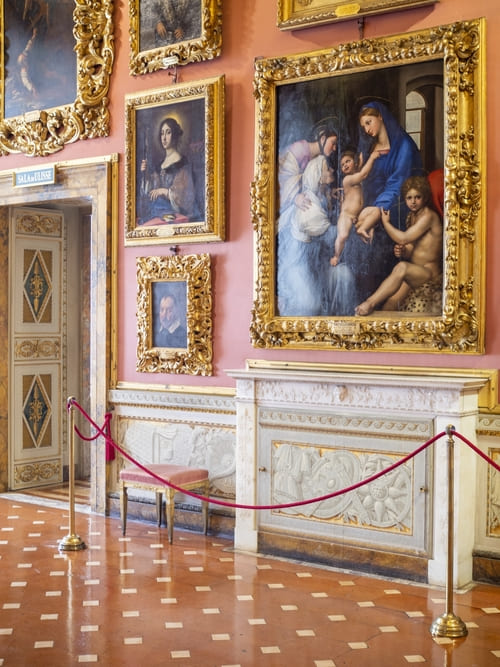
In addition to Raphael, the gallery also features masterpieces by other iconic Italian and European artists, including Botticelli, Caravaggio, Artemisia Gentileschi, Titian, Rubens, and many more.
Modern Art Gallery
At the Palace you’ll find the Modern Art Gallery, which features a rich collection of 19th-century paintings.
A visit to the gallery offers an introduction to the history of the Florentine school of Neoclassicism and 19th-century historical painting.
You’ll also have the opportunity to learn more about the so-called Macchiaioli movement, which is prominently represented in the collection inherited from art critic Diego Martelli.
The Macchiaioli were 19th-century painters, whose art shared some ideas with the painting of the French Impressionists. Just like their French colleagues, the Macchiaioli, began using brighter colors and wanted to capture beautiful light effects in their works.
Museum of Costume and Fashion
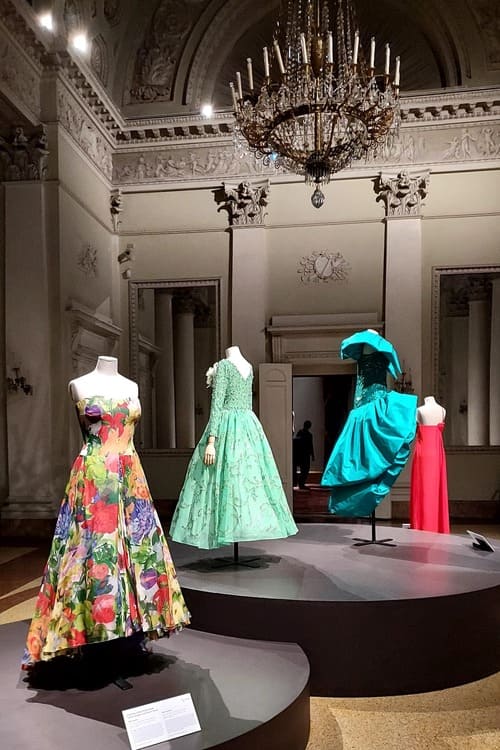
Another fascinating museum within the Pitti Palace is the Museum of Costume and Fashion, located in the Palazzina della Meridiana – the smaller wing of the palace built by the Habsburg-Lorraine dynasty.
This museum highlights Florence’s historical and ongoing significance in the world of fashion. In fact, in 1952, the Pitti Palace became an international fashion hub, hosting runway shows that launched the careers of some of Italy’s most iconic fashion houses, including Emilio Pucci and Valentino.
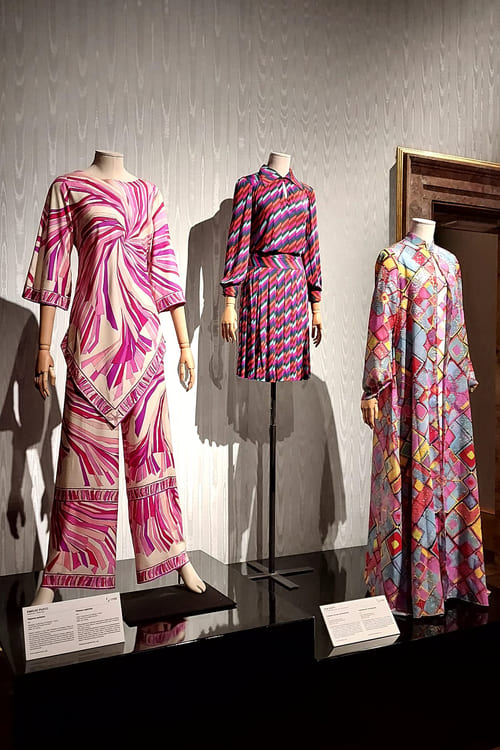
These shows were held in the famous White Room on the first floor of the palace and continued for three decades, from 1952 to 1982, marking a pivotal era in Italian fashion history.
Today, Florence’s strong connection to fashion endures not only through events like Pitti Uomo – held annually at the Fortezza da Basso – but also through the rich collection at the Museum of Costume and Fashion.
The museum features historic garments such as the funeral dress of Duchess Eleonora of Toledo, along with a stunning array of accessories and creations by legendary designers like Schiaparelli and Fortuny.
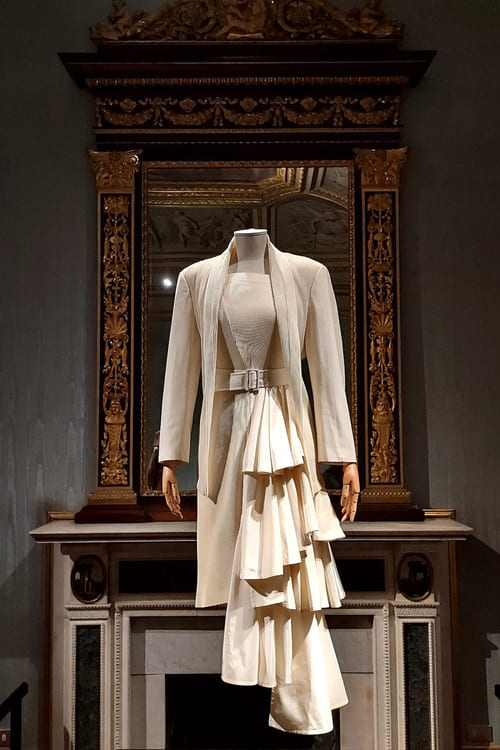
This museum is a must-see for all fashion lovers visiting Florence.
Treasury of the Grand Dukes
The Treasury of the Grand Dukes is another remarkable museum housed within the Pitti Palace, occupying what were once the Medici’s summer apartments on the ground and mezzanine floors.
This museum offers a captivating journey through the opulence of the past, showcasing a stunning array of semi-precious stone vases, rock crystals, amber, ivory objects, and exquisite silverware from the prestigious collections of both the Medici and Habsburg dynasties.
One of the most fascinating aspects of the exhibition is its impressive jewelry collection, which spans from the 17th and 18th centuries to more contemporary pieces crafted in the 20th century.
The museum beautifully reflects the evolution of decorative arts over the centuries and is a must-visit for anyone intrigued by the intersection of history, craftsmanship, and luxury.
Visit Palazzo Pitti: what to know?
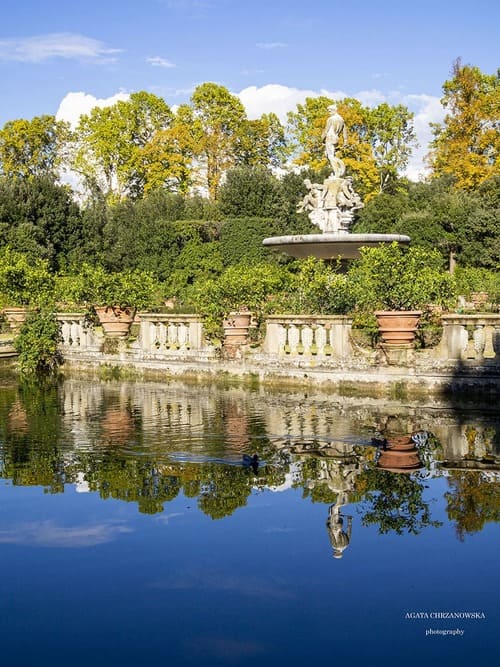
When planning a visit to the Pitti Palace, you will have to take this important decision:
- whether to explore the entire complex, including all the museums it houses,
- or to focus on just a selection of its rich collections.
The palace offers a diverse range of experiences, each catering to different interests.
At the heart of the complex lies the Palatine Gallery, the most prestigious museum within the palace, home to masterpieces by great European artists such as Raphael, Titian, Rubens, and Caravaggio.
For those drawn to Impressionism and 19th-century art, the Gallery of Modern Art is a highlight, while the Museum of Costume and Fashion is an unmissable stop for fashion enthusiasts.
The palace is also directly connected to the magnificent Boboli Gardens – a rare and splendid example of a Baroque representative garden designed behind the private residence of a European ruling family.
Whether you’re passionate about painting, fashion, or garden architecture, the Pitti Palace offers a multifaceted journey through Florence’s cultural legacy.
Pitti Palace, Florence, Italy: visitor information
A visit to the Palatine Gallery and the Boboli Gardens typically takes around three hours, or up to half a day.
However, if you’re eager to explore more of the extensive museum complex housed within the Pitti Palace, it’s well worth dedicating a full day.
Where is the Palazzo Pitti located?
Located in the Oltrarno district – on the opposite side of the Arno River from Florence’s Cathedral and Town Hall (Palazzo Vecchio) – the Pitti Palace is easily accessible. Simply cross the river via Ponte Vecchio and continue straight for about five minutes to arrive at this magnificent historic residence.
Florence Palazzo Pitti: opening hours and tickets
The palace is open to visitors from Tuesday to Sunday, with operating hours from 8:15 a.m. to 6:50 p.m. (last entry typically around 5:45 p.m.).
It’s closed on Mondays.
Admission to the entire museum complex is €19, while a combined ticket that includes access to the Boboli Gardens is €25 per person.
The gardens follow a slightly different schedule depending on the season:
- during the winter months (January, February, and November), they close at 4:30 p.m. with last entry at 3:00 p.m.;
- in March, closing time extends to 5:30 p.m.;
- from April to October – thanks to daylight saving time – they remain open until 6:30 p.m.;
- in the summer months (June, July, and August), visitors can enjoy the gardens until as late as 7:10 p.m., offering a perfect end to a cultural day in Florence.
Palazzo Pitti Florence: 3 tips
Here are three essential tips to make the most of your visit to the Pitti Palace.
- First, when exploring the Palatine Gallery, be sure not to miss the masterpieces by Raphael – these iconic works are among the highlights of the entire collection.
- Second, plan your visit to the Boboli Gardens carefully, especially during the summer months. The gardens, designed in the Baroque Italian style, offer limited shaded areas, making midday visits in July or August – when temperatures can soar to 40°C (over 100°F) – uncomfortably hot. It’s best to explore the gardens in the early morning or late afternoon to avoid the peak heat.
- Lastly, given the vast size of the palace and the number of museums it houses, it’s wise to select the collections that interest you most and focus your visit accordingly. This thoughtful approach will ensure a more enjoyable and meaningful experience within this grand Florentine landmark.
Why should you visit Pitti Palace with a private guide?
Due to the sheer size and richness of the Pitti Palace, organizing a guided tour can be especially beneficial.
A knowledgeable guide can help tailor your visit based on your personal interests, allowing you to focus on the collections and areas that matter most to you. This not only ensures a more efficient use of your time but also enriches your experience with deeper insights into the palace’s history, art, and architecture.
A guided tour of the Pitti Palace is highly recommended for anyone seeking to fully appreciate the cultural treasures within.
If you’re planning a trip to Florence and are in search of a professional guide, contact us!
We are happy to organize your museum visits and cultural tours to make your stay truly unforgettable.


